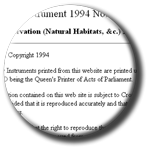Naturenet: The Conservation (Natural Habitats, &c.) Regulations 1994
The Conservation of Habitats and Species Regulations 2010
T
 he main Acts for protection of biodiversity in England
and Wales are the Wildlife and Countryside Act 1981
he main Acts for protection of biodiversity in England
and Wales are the Wildlife and Countryside Act 1981 , and the Countryside
and Rights of Way Act 2000
, and the Countryside
and Rights of Way Act 2000 . However, there is another layer of legislation produced at a European
level. This is an EU Directive which is produced to have effect at a national
level as regulations, and although there are many such regulations which have
an impact on environmental matters, the most important is the rather clumsily-named
Conservation (Natural Habitats, &c.) Regulations 1994; subsequently consolidated into the Conservation of Habitats and Species Regulations 2010. As these names are
either unpronouncable in normal speech or just too tedious to remember, the regulations (either the 1994 or 2010 ones) are sometimes informally
known as 'The Habitats Directive', 'The Habitats Regulations' or just 'HabsRegs'.
It is worth noting that the Directives in themselves have no force in law, it is
the national regulations, made to comply with the Directives, which are the
legal vehicle for these powers.
. However, there is another layer of legislation produced at a European
level. This is an EU Directive which is produced to have effect at a national
level as regulations, and although there are many such regulations which have
an impact on environmental matters, the most important is the rather clumsily-named
Conservation (Natural Habitats, &c.) Regulations 1994; subsequently consolidated into the Conservation of Habitats and Species Regulations 2010. As these names are
either unpronouncable in normal speech or just too tedious to remember, the regulations (either the 1994 or 2010 ones) are sometimes informally
known as 'The Habitats Directive', 'The Habitats Regulations' or just 'HabsRegs'.
It is worth noting that the Directives in themselves have no force in law, it is
the national regulations, made to comply with the Directives, which are the
legal vehicle for these powers.
The
Conservation (Natural Habitats, &c.) Regulations
1994 transposed Council Directive 92/43/EEC on the conservation of natural
habitats and of wild fauna and flora (EC Habitats Directive) into national
law (footnote 1). The Regulations came into force on 30
October 1994, and have been subsequently amended in 1997(footnote3)
and (in England only) 2000 (footnote 4) . Containing five Parts and four
Schedules, the Regulations provide for the designation and protection of
'European sites', the protection of 'European protected species', and the
adaptation of planning and other controls for the protection of European
Sites. These regulations accumulated a lot of amendments which eventually were consolidated into a new set of regulations.
The Conservation of Habitats and Species Regulations 2010 came into force on 1 April 2010 to consolidate all the various amendments made to the Conservation (Natural Habitats, &c.) Regulations 1994 in respect of England and Wales. The 1994 Regulations transposed Council Directive 92/43/EEC on the conservation of natural habitats and of wild fauna and flora (EC Habitats Directive) into national law. In Scotland the Habitats Directive is transposed through a combination of the Habitats Regulations 2010 (in relation to reserved matters) and the 1994 Regulations. The Conservation (Natural Habitats, &c) Regulations (Northern Ireland) 1995 (as amended) transpose the Habitats Directive in relation to Northern Ireland. These are similar in effect, but note that the rest of this page refers specifically to England and Wales.
The 2010 Regulations provide for the designation and protection of 'European sites', the protection of 'European protected species', and the adaptation of planning and other controls for the protection of European Sites. Under the Regulations, competent authorities i.e. any Minister, government department, public body, or person holding public office, have a general duty, in the exercise of any of their functions, to have regard to the EC Habitats Directive.
New provisions implement aspects of the Marine and Coastal Access Act 2009 (the “Marine Act”). These provisions provide for: the transfer of certain licensing functions from Natural England to the Marine Management Organisation; Marine Enforcement Officers to use powers under the Marine Act to enforce certain offences under the Habitats Regulations.
The Regulations place a duty on the Secretary of State to propose a list of sites which are important for either habitats or species (listed in Annexes I and II of the Habitats Directive respectively) to the European Commission. Once the Commission and EU Member States have agreed that the sites submitted are worthy of designation, they are identified as Sites of Community Importance (SCIs). The EU Member States must then designate these sites as Special Areas of Conservation (SACs) within six years. The Regulations also require the compilation and maintenance of a register of European sites, to include SACs and Special Protection Areas (SPAs) classified under Council Directive 79/409/EEC on the Conservation of Wild Birds (the Birds Directive). These sites form a network termed Natura 2000.
The Regulations enable the country agencies to enter into management agreements on land within or adjacent to a European site, in order to secure its conservation. If the agency is unable to conclude such an agreement, or if an agreement is breached, it may acquire the interest in the land compulsorily. The agency may also use its powers to make byelaws to protect European sites. The Regulations also provide for the control of potentially damaging operations, whereby consent from the country agency may only be granted once it has been shown through appropriate assessment that the proposed operation will not adversely affect the integrity of the site. When considering potentially damaging operations, the country agencies apply the precautionary principle' i.e. consent cannot be given unless it is ascertained that there will be no adverse effect on the integrity of the site.
In instances where damage could occur, the appropriate Minister may, if necessary, make special nature conservation orders, prohibiting any person from carrying out the operation. However, an operation may proceed where it is or forms part of a plan or project with no alternative solutions, which must be carried out for reasons of overriding public interest. In such instances the Secretary of State must secure compensation to ensure the overall integrity of the Natura 2000 system. The country agencies are required to review consents previously granted under the Wildlife and Countryside Act 1981 for land within a European site, and may modify or withdraw those that are incompatible with the conservation objectives of the site.
The Regulations make special provisions for the protection of European marine sites, requiring the country agencies to advise other authorities of the conservation objectives for a site, and also of the operations which may affect its integrity. The Regulations also enable the establishment of management schemes and byelaws by the relevant authorities and country agencies respectively, for the management and protection of European marine sites.
The Habitats Regulations apply only as far as the limit of territorial waters (12 nautical miles from baseline). The Offshore Petroleum Activities (Conservation of Habitats) Regulations 2001 apply the Habitats Directive and the Birds Directive in relation to oil and gas plans or projects wholly or partly on the United Kingdom's Continental Shelf and superjacent waters outside territorial waters (the UKCS).
The Regulations make it an offence (subject to exceptions) to deliberately capture, kill, disturb, or trade in the animals listed in Schedule 2, or pick, collect, cut, uproot, destroy, or trade in the plants listed in Schedule 4. However, these actions can be made lawful through the granting of licenses by the appropriate authorities. Licenses may be granted for a number of purposes (such as science and education, conservation, preserving public health and safety), but only after the appropriate authority is satisfied that there are no satisfactory alternatives and that such actions will have no detrimental effect on wild population of the species concerned.
The Regulations require competent authorities to consider or review planning permission, applied for or granted, affecting a European site, and, subject to certain exceptions, restrict or revoke permission where the integrity of the site would be adversely affected. Equivalent consideration and review provisions are made with respects to highways and roads, electricity, pipe-lines, transport and works, and environmental controls (including discharge consents under water pollution legislation). Special provisions are also made as respects general development orders, special development orders, simplified planning zones and enterprise zones.
1. Equivalent provisions for Northern
Ireland were contained within the Conservation
(Natural Habitats, etc.) Regulations 1995.
2. When
considering potentially damaging operations, the conservation agencies apply
the precautionary principle' i.e. consent cannot be given unless it is ascertained
that there will be no adverse effect on the integrity of the site.
3.
The Conservation
(Natural Habitats, &c.) (Amendment)
Regulations 1997 (Statutory Instrument 1997 No. 3055)
4. The
Conservation (Natural Habitats, &c.) (Amendment)
(England) Regulations 2000 (Statutory Instrument 2000 No. 192)
5. The
Offshore Petroleum Activities (Conservation of Habitats) Regulations 2001
(Statutory Instrument 2001 No. 1754)
The text on which this page is based is Crown Copyright, used with permission,
and taken from the Joint Nature Conservation
Committee.

